Can You Mix Dot 3 and Dot 5 Brake Fluid
Brake fluid is an essential part of the hydraulic braking system. Without it, or without enough if information technology, the forces you lot apply at the restriction lever would not be transferred to the caliper, pads and rotor.
One of the great debates and areas of confusion surrounding brake fluid is which brake fluid is superior?
Most of you will know that hydraulic brakes are designed to utilize one of 2 principal types of brake fluid - DOT fluid or Mineral Oil, and which ane you pick is not a choice fabricated by you or me, but rather by the restriction manufacturers themselves. But which restriction fluid is best and why practise we have two to begin with?
Well we're going to try and answer those questions today. I'll explore these restriction fluids in detail, sum up their advantages and disadvantages and explain why the experts believe their choice of fluid is best for u.s. riders. Permit's get started..
The Role of the Restriction Fluid
If you lot've read How Hydraulic Brakes Work you will know that brakes tedious the states down by turning kinetic energy into heat past using friction.
Brake fluid is only 1 of several vital components which enable hydraulic brake systems to work effectively. Its job is to transfer the input forces you create at the master cylinder (lever) to the caliper pistons. This is possible as fluids are generally incompressible.
The brake fluid also has to resist, equally far equally possible, the loftier temperatures created past the braking forces.
Types of Brake Fluid
At that place are two types of brake fluid used in hydraulic mountain bike brakes today:
- DOT Fluid
- Mineral Oil
DOT Fluid
Certainly the virtually commonly used brake fluid in apply today, due to its wide use in the automotive industry, is DOT fluid. All DOT fluids (with the exception of DOT v) are made upwards of a poly-glycol base of operations.
Glycol-based fluids consist of a mixture of ingredients with equally many equally 10 separate substances making up the final product. These substances can exist broken down into four central components:
- A lubricant, such as polythene or polypropylene, to keep parts moving freely - xx-40%.
- A solvent diluent, usually glycol ether, which determines the fluid's boiling point and viscosity and accounts for 50-80% of the fluid.
- A modifier-coupler, which changes the corporeality of swelling of exposed rubber parts.
- Inhibitors, to prevent corrosion and oxidisation.
DOT brake fluid is required to meet strict standards and specifications set out by the Society of Automotive Engineers and the Section of Transportation (DOT) - hence the name. These standards center effectually maintaining brake fluid performance in a range of temperatures (high and low) and also specify the minimum boiling temperatures which the fluid manufacturers must attach to.
Boiling Temperatures
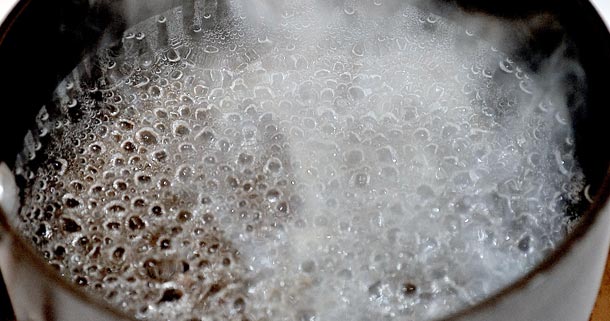
Ane of the main differences separating the various classes of DOT fluid is their boiling temperature (or humid indicate). This refers to the temperature where the brake fluid will start to boil or vapourise inside the brake organisation. This is acquired by the intense heat created after prolonged, heavy brake use and has an agin effect on the performance of the entire brake organisation.
What happens when restriction fluid starts to boil?
When brake fluid absorbs enough oestrus information technology boils and vaporises. It turns from a fluid into a gas. This gas can pb to complete restriction failure in hydraulic systems. Suddenly the incompressible nature of the restriction fluid, which produces the firm lever feel that we know and trust, has disappeared due to the introduction of compressible gasses in the brake system.
Now all of the input forces usually created by squeezing the restriction lever are lost as they get into compressing the air bubbling within the fluid instead. Now the brake fluid can no longer transfer these forces to the caliper leading to restriction failure - this is known as 'fluid fade'.
Let's have a expect at the minimum humid temperatures of DOT brake fluid equally specified past the regulatory bodies.
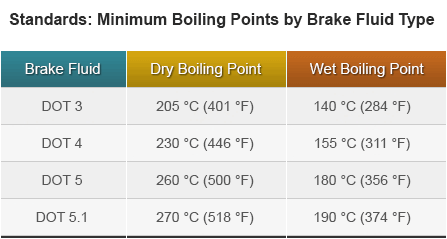
Note that these are the minimum boiling temperatures as outlined by the Department of Transportation and do no always reflect the true humid points of the different brands of DOT fluid on the market place today. Fluid manufacturers can and do better on these temperatures with some restriction fluids reaching dry boiling temperatures well in excess of 300°C/572°F.
What is meant by dry and wet boiling points?
The Dry Boiling Point of restriction fluid refers to the boiling temperature of fresh, new restriction fluid from an unopened container. Whereas the Wet Boiling Signal is defined as the temperature DOT brake fluid will begin to boil afterward it has absorbed 3.7% water by volume. DOT brake fluid will achieve this level of h2o volume after roughly 2 years of service, which is why information technology is appropriate to renew your brake fluid every year.
The furnishings of this water content over time are ameliorate illustrated by the graph beneath. This graph is taken from Vanquish and gives an overview of the declining upshot water content has on its range of DOT 3 and DOT 4 brake fluids.
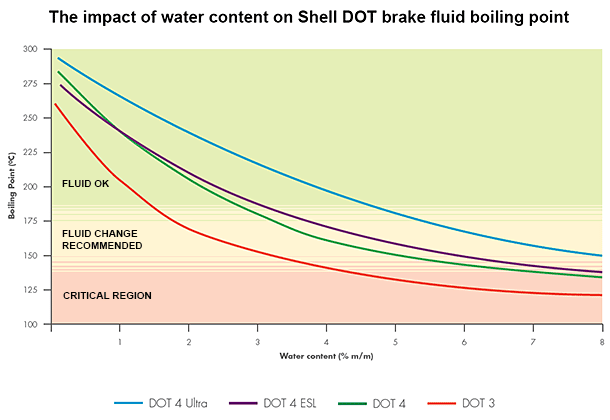
Permit'due south retrieve that the Department of Transportation specify the minimum wet boiling point of DOT brake fluids after absorbing only 3.7% water content (roughly 2 years service). In the graph in a higher place we can run into that the boiling points of the various Shell DOT fluids decline much farther over longer periods of time. When brake fluid reaches 8% water content the boiling point of Shell DOT three brake fluid has been reduced almost to that of water - 100°C!
So where does this water come from?
Glycol based fluids are hygroscopic which means they blot h2o/moisture from the surroundings at normal atmospheric pressures at a rate of 2-3% per year. This process is exasperated in more humid weather and climates.
This water content finds its way into the restriction fluid via microscopic pores in brake hoses, seals, joints and seams. Equally we've learnt, h2o mixed with DOT fluid has an adverse effect on the brake fluid past reducing its boiling temperature and therefore reducing its operation.
Hell no H2o!

Hold on a second, although we've just made water out to expect like your new worst enemy, the hygroscopic nature of DOT brake fluid is actually an advantage in a major mode.
Every bit water enters the organization, instead of pooling in low spots (such every bit the caliper), due to its weight in comparison with brake fluid, it is dispersed throughout the whole of the brake fluid. This helps to keep the boiling point of the entire brake fluid high rather than having pools of water in the system which will boil much sooner than the rest of the brake fluid.
It also prevents localised corrosion of internal parts which can be acquired by water pooling in the brake organisation.
So what about DOT 5 brake fluid?
DOT v restriction fluid (not to exist confused with DOT 5.1) is fundamentally dissimilar than the rest of the DOT fluid range in that it is silicone based brake fluid.
It was originally introduced to give a college boiling temperature over glycol-based DOT four restriction fluid. Purple in colour and sometimes referred to every bit 'constructed brake fluid', DOT five is not compatible with any of the glycol-ether based DOT fluids that we've been focusing our attention on and so far.
Although tests have been carried out past the various hydraulic mountain wheel brake manufacturers, DOT 5 has and so far not proven itself to be a meliorate alternative to glycol-ether based fluids used in hydraulic mountain wheel brakes today.
It is likewise more compressible than the other DOT brake fluids which can pb to a sluggish or spongy brake lever (or pedal) feel, and therefore requires special design considerations when used in brake systems.
Furthermore DOT five is hydrophobic and does not blot water from the atmosphere similar regular DOT brake fluid volition.
So what is it adept for?
Due to its hydrophobic properties it has a very long life-span meaning low maintenance and fewer fluid changes. It is as well kinder to paintwork dissimilar corrosive glycol-ether based DOT fluids.
A good example of its employ is in military vehicles which can be stored for long periods of time just need to exist set up to exist used at a moments notice. It is also favoured past some owners of classic cars for vehicles which may also rarely be used on the roads.
Mineral Oil
Unlike DOT brake fluid, Mineral Oil restriction fluids are not governed by any standards or regulatory trunk, therefore the technical information on the various substances that contribute to their brand-upwards is usually hard to come by. The likes of Shimano and Magura have no doubt spent a lot of time and money refining their proprietary Mineral Oil brake fluids so y'all tin understand why there is a degree of secrecy on the subject.
But is the lack of a governing 'rule book' for Mineral Oil bad thing? Here'due south what Shimano take to say:
| "Nosotros actually run across this every bit a major advantage of using Mineral Oil. We don't have to trust anyone else'south testing standards for the fluid they make. Since every Shimano restriction uses Shimano brake fluid, we have consummate control over the process and tin can assure consistent functioning." |
| - Nick Murdick, Lead Multi Service Technician - Shimano |
Information technology'due south a convincing statement. It'due south like shooting fish in a barrel to understand why a huge organisation like Shimano, with their kind of budget, would want complete control over the production of their brake fluid.
Mineral Oil Humid Temperatures
Ok, so now we're getting downwardly to the nitty gritty, this is where Mineral Oil differs greatly from DOT brake fluid.
Different DOT fluid, Mineral Oil is hydrophobic and does non blot moisture from the environment. This ways that there are no moisture or dry boiling temperatures to worry nigh, the boiling betoken stays abiding and never drops. That's the good news.
The bad news is that any water that does enter the brake system, via seals or microscopic pores in the lines etc., will effectively reduce the humid point of the whole brake system to that of water - only 100°C. This is because every bit the fluid repels any water ingress, information technology causes it to pool at low points within the brake system, usually the caliper, since h2o is heavier than brake fluid information technology will settle at the lowest point. This is worrying because the fluid in the caliper is more susceptible to high temperatures as it's at the business end of the brake, where the friction is created.
You lot might think that since the boiling betoken of Mineral Oil never drops then the trade-off must be that it must start much lower than DOT fluid, after all you can't have the best of both worlds tin can yous? Well recent discoveries advise that might not be the case. Allow'due south accept a expect at some of the figures we know of.

Yes, we were surprised also! Magura Royal Blood Mineral Oil has a ridiculously low humid temperature when compared with its rivals in the industry. Even LHM+ outweighs Royal Blood with a fluid that has a 107% higher boiling temperature. The reasons backside this low temperature is unknown, all we know is that Magura Royal Blood is based on Castrol Vitamol V10 hydraulic fluid.
All of these figures have been provided by the manufacturers themselves. The second surprise here is the fact that Juice Lubes' Mineral Oil appears to out-perform even Shimano's ain Mineral Oil, albeit by a very small margin, but a victory nonetheless. :)
Brake Fluid Shelf Life

DOT Brake Fluid
The shelf life of glycol-based DOT brake fluid is very poor due to its hygroscopic properties, which is why every bottle should come up with an air tight foil liner roofing the opening. Every bit soon as this air tight seal is cleaved it will start absorbing moisture from the environment and the humid point will brainstorm to drop.
Castrol recommends that DOT fluid in previously opened containers should be discarded afterwards 12 months. In our opinion it would be unwise to use DOT fluid from a bottle which has been open for more than a few months, unless yous have no other alternative.
To reduce large quantities of wasted brake fluid, apply DOT fluid from smaller 100ml bottles. 100ml is plenty to bleed a set of brakes (front and rear) 2-3 times.
Mineral Oil
Since Mineral Oil is hydrophobic and does non absorb water from its surround, one of the great advantages it has over DOT fluid is that once opened it can be stored indefinitely.
Compatibility Between Brake Fluids

So just which brake fluids tin you mix without causing harm to your brake organisation? Allow'southward take a look at the chart below.

Every bit you tin can see all of the glycol- based DOT fluids (3, 4 & 5.i) are fully compatible with each other and tin can exist readily mixed or swapped without adversely affecting the brake'southward performance or its characteristics. The main modify will come in a decrease or increment in the boiling signal of the brake fluid as a whole.
For case if you introduced DOT 3 into a brake previously filled with DOT v.1 so you volition probably be left with a restriction fluid with a lower humid point. I say 'probably' as information technology depends on the service life of the older fluid but you get the thought - not a smashing deal can get incorrect mixing glycol-based DOT fluids.
Silicone DOT 5, as nosotros mentioned before, is not compatible with any of the other DOT fluids, nor is it able to exist mixed with Mineral Oil brake fluid. Since there is no hydraulic mountain wheel brakes using DOT five fluid nosotros won't worry too much most it. The main thing to recollect is it should never be confused with DOT 5.1 as they are fundamentally different brake fluids.
What nearly compatibility between Mineral Oil brake fluids?
Here's where things get a chip hazy. Unlike DOT fluid which is pretty clear cutting, mixing Mineral Oils is an altogether unlike story.
We at EBS had believed that all Mineral Oils manufactured for use in hydraulic brakes (not the stuff you tin buy from the local pharmacy or drug shop) are compatible with each other, only our before thoughts were questioned after reading a very informative Q&A session conducted past the skillful folks at Cycle Rumor recently.
vii questions regarding brake fluid and its implications for use with hydraulic route disc brakes were directed at the superlative brake manufacturers and the unedited replies were published.
One Shimano representative revealed that no tertiary party Mineral Oil has ever been sanctioned for use in Shimano brakes - this we expected to hear as Shimano will of class be recommending you lot use their proprietary brake fluid. However he went on to state, with 'accented certainty', that 'Magura fluid volition destroy Shimano brakes in a very short corporeality of time.'
This got us thinking. Are Shimano merely trying to put the frighteners on people so they use nothing just Shimano's own branded Mineral Oil? Nosotros contacted Will Miles of Juice Lubes, who manufacture a range of lubricants, cleaners and brake fluids (including Mineral Oil), to get their take on this and here's what they said when it comes to compatibility between Mineral Oils:
| "Our view is quite unproblematic in that having tested our Mineral and DOT oil in all Mineral and DOT systems we are happy to recommend it for whatever brand of brake manufacturer including Shimano. We have sold thousands and thousands of units worldwide and never had any problems reported. Clearly the manufacturers accept a vested involvement in recommending and insisting that consumers employ only in that location oil and to exist fair why wouldn't they? It does make perfect commercial sense and does permit them to maintain quality command standards so I tin can completely sympathize in that location point of view and stance on the matter. Equally Juice Lubes is a not-OE supplier, all we can exercise is exam our products, ensure they are of the highest grade and work every bit intended - which is exactly what we practice." |
| - Volition Miles, Juice Lubes |
Thanks Will. After thousands of units sold and no issues reported maybe Shimano could exist defendant of exaggerating slightly - but that'southward just my view. In any case, one thing to remember at all times when because swapping out your Shimano or Magura proprietary Mineral Oil is that you may void the restriction'due south warranty in the procedure. Yous've been warned.
Which Brake uses which Brake Fluid?
So which brake fluid should y'all be using with your brake set? Well that of course depends on your brake model. You volition usually find the type of fluid your brake was designed to apply printed somewhere on the lever assembly or reservoir top cap. This makes it easy to identify and saves you from making the fatal error of introducing the wrong fluid and destroying your brake's internal seals.
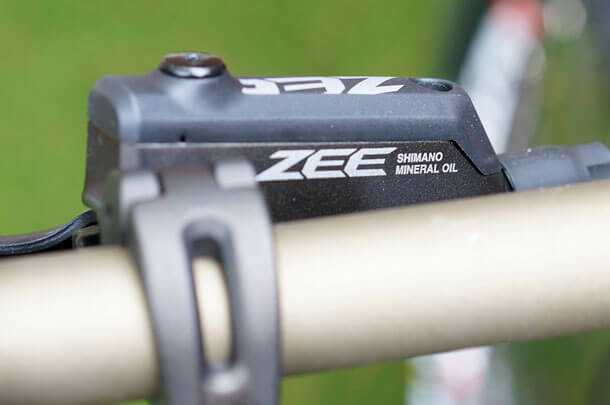
But while we're on the subject field permit's have a look at which style the various brake manufacturers lean when information technology comes to brake fluid choice. Take a expect at the table below.
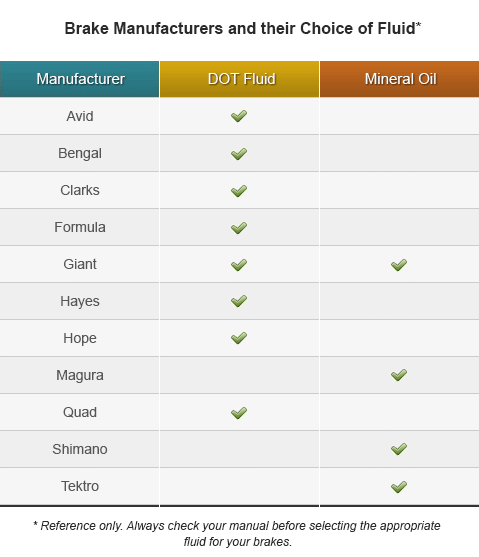
From that motion-picture show it'due south clear to meet that DOT fluid is used by the vast majority of hydraulic brake manufacturers on the bicycle scene, however does that necessarily mean it's the best choice for users? Permit's zoom out a little and take a look at the strengths and weaknesses of each fluid.
Advantages and Disadvantages

So here it is. This is where I'm going to give you an overview of the advantages and disadvantages of each restriction fluid as I see them. Permit'due south start with DOT fluid and remember that the points below apply to glycol-based DOT fluids just, we're excluding silicone DOT 5 as it is not used in whatsoever hydraulic cycle brakes that nosotros know to.
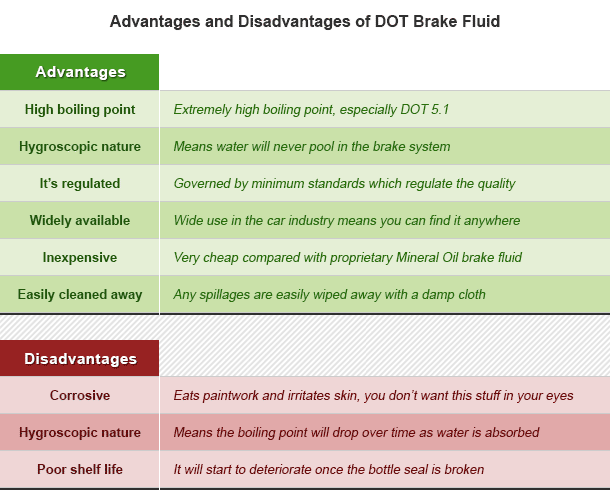
Every bit you lot can see, there are a lot of positive points about DOT brake fluid, non least the fact that information technology can be establish pretty much anywhere at less than half the cost of Mineral Oil. In that location's good news and bad news when it comes to its water-absorbing properties, that is why y'all'll find I have entered it in both tables to bear witness both sides of the story.
On this particular point I personally feel that the benefits massively outweigh the drawbacks. Changing your restriction fluid annually to conquer the drib in boiling point is a small price to pay to avert having water pooling in your brake system.
Also the fact that it is regulated by the federal government means that the brake manufacturers tin can concentrate on edifice brakes instead of formulating restriction fluid, and be safety in the knowledge that the DOT fluid they're designed to be used with is of consequent high quality regardless of who should manufacture information technology.
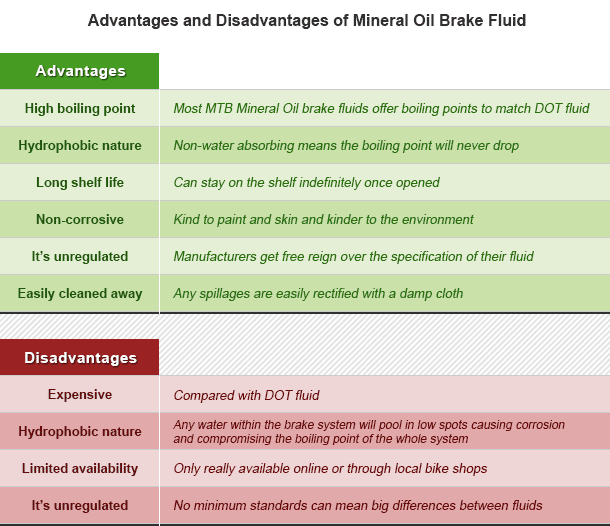
A huge disadvantage of Mineral Oil, or proprietary brake fluid, is the cost. As information technology is one-of-a-kind, there'south no competition (as such) and the warranty says you should use it, they tin basically accuse what they similar for it - and they practise. Not cool!
In contrast to DOT brake fluid, Mineral Oil is not a regulated fluid. This means that the likes of Shimano and Magura have the added freedom when it comes to its manufacture. Shimano certainly see this every bit an advantage as they 'don't have to trust anyone else's testing standards' and can pretty much guarantee the results. A sceptic would also point out that they tin can also make money off the dorsum of fluid sales as an extra revenue stream.
Another great matter about Mineral Oil is that it does not destroy your paintwork, something which is very important equally bikes and bike gear gets shinier by the calendar week. Don't blemish that bling now! :)
And the Winner is..
Then at that place it is. A break down of the two restriction fluids in utilise in hydraulic mountain bicycle brakes today. Both very different in their make-up, and with their own set up of characteristics but ultimately performing the same function. By now you will capeesh that there is more to the great brake fluid debate than only discussing boiling temperatures.
Which ultimately leaves only one question - which one is best?
Well, why don't yous tell us? You've heard the evidence, now it'south time to cull your overall winner using the poll and telling usa why in the comments below.
Sources:
Bike Rumor - Tech Speak: Brake Fluid Break Down & Implications for Road Disc
Castrol - Product Data Sheet: Super Response DOT 4
Valvoline - LHM Plus product information and data canvas
Guild of Automotive Engineers International - Standard J1703: Motor Vehicle Restriction Fluid
Lawmaking of Federal Regulations - Standard No. 116; Motor vehicle brake fluids
Epitome credits: Shell, Tord Mattsson

Alex Mansell, Head honcho
Shares tips and advice on the night-fine art of brake-haemorrhage. Rides bikes when time permits.
Facebook | Instagram | Twitter
Source: https://epicbleedsolutions.com/blogs/articles/dot-brake-fluid-vs-mineral-oil
0 Response to "Can You Mix Dot 3 and Dot 5 Brake Fluid"
Post a Comment